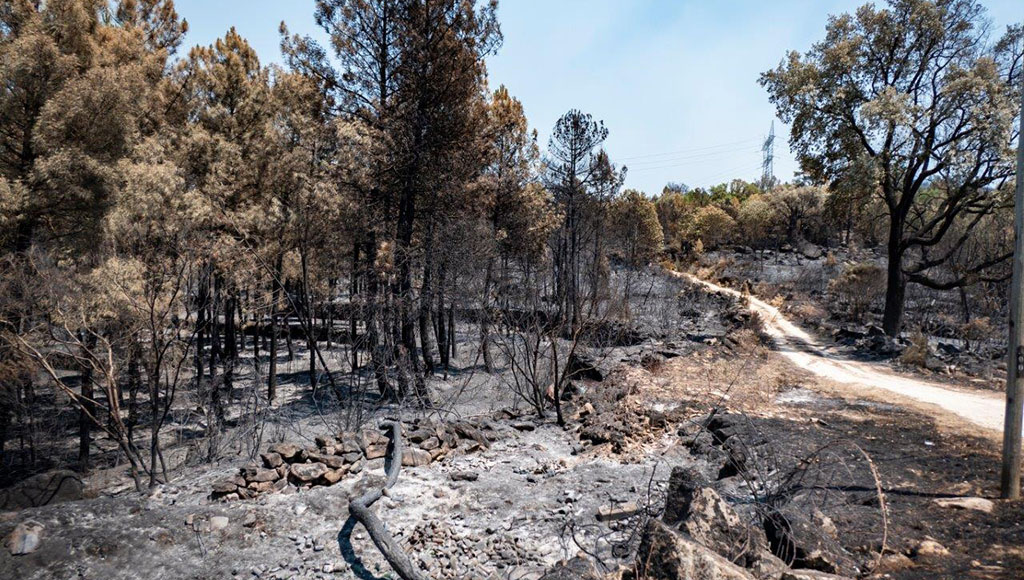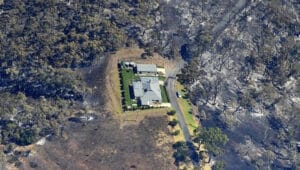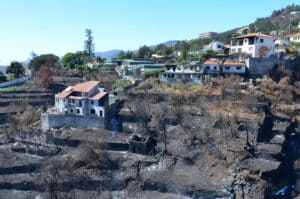With the start of the new hydrological year on October 1 and the consequent approach of a period in which greater rainfall will naturally occur, the risk of urban flooding will increase significantly and, consequently, the vulnerability of people and property to their effects.
The main causes of minor floods are obstructions to the circulation and regular drainage of rainwater. This can be due to: materials accumulated at the mouths of drainage systems; blockage of roadside water channels; the abandonment of waste from agricultural, forestry and inert material extraction activities along communication routes and within water courses.
Rural fires
Vegetation is crucial for slope stability as it offers root support, regulates water content, and protects the soil surface. Fires can lead to slope failure by destroying vegetation, weakening root systems, and altering soil structure. Rainfall, especially intense rainfall, following fires in burned areas can, therefore, result in landslides and loose objects may be dragged onto roads.
These risks can be increased when major fires occur very close to the beginning of the hydrological year and start of rainfall – as was the case this year.
The immediate or direct threats of a forest fire are the loss of human lives, partial or total destruction of private property, damage to infrastructures and loss of natural resources. However, after a forest fire, changes in vegetation, surface coverage conditions and/or hydrological processes can increase the probability and consequences of slope instability phenomena, which can affect the areas in front or above the slopes long after forest fire extinction.
In general, the first 4-6 months after the fire is the period of greatest vulnerability because of the likelihood of intense rainfall associated with the autumn-winter period and because vegetation has not yet regrown. However, the window of disturbance is estimated to last between 3 to 10 years, depending on several factors.
It is important, therefore, to be prepared for the precipitation that marks autumn by adopting prevention and self-protection measures. The need to mitigate the risks associated with possible periods of precipitation, which could be strong and prolonged, the intensification of the wind and the worsening of sea conditions, imply the early taking of collective and individual preparation measures.
Expected effects
Apart from slope instability following fires mentioned earlier, effects include flooding in urban areas, caused by the accumulation of rainwater due to the obstruction of drainage systems. Other effects can be floods enhanced by the overflow of the bed of some watercourses, rivers and streams, and enhanced by the abandonment of waste from agricultural, forestry and waste extraction activities. It is important to be on the lookout of the dragging of loose objects to the roadways, or loosening of mobile or poorly-fixed structures due to strong winds, which can cause accidents with vehicles in circulation or passers-by on the public road and causing the degradation of road sections.
What is a hydrological disaster?
Experts deem any violent or abnormal movement of water on land as a hydrological disaster. This can include bodies of water that overflow, heavy precipitation, changes in water quality, or atypical behaviour of water sources. Flooding and events that cause flooding are often identified as hydrological disasters, although this also can include disasters of other classification such as meteorological disasters like hurricanes and storms.
NOAA National Weather Service forecasters at the Climate Prediction Centre predicted in May there would be above-normal hurricane activity in the Atlantic basin this year. NOAA’s outlook for the 2024 Atlantic hurricane season, which spans from June 1 to November 30, predicted an 85% chance of an above-normal season, a 10% chance of a near-normal season and a 5% chance of a below-normal season. NOAA is forecasting a range of 17 to 25 total named storms (winds of 39 mph or higher). Of those, eight to 13 are forecast to become hurricanes (winds of 74 mph or higher), including four to seven major hurricanes (category 3, 4 or 5; with winds of 111 mph or higher). Forecasters have a 70% confidence in these ranges.
So far there have been far less, but activity is now picking up with the possibility we may yet experience a direct storm.
As with geophysical disasters, the risk of a hydrological disaster developing can depend on factors of location. Communities that are close to major bodies of water-oceans, seas, large lakes and rivers, etc., are going to have a higher risk of experiencing a hydrological disaster than those that are not located near water sources.
Man-made surfaces in urban areas, such as roads and parking lots, need sewers and storm drains because concrete and asphalt are not water absorbent. Thus, such environments are easily prone to flooding caused by hydrological disasters as there often isn’t enough drainage available, and debris can easily block drainage access on underpasses, basements, parking lots and garages, and densely populated areas like a city’s downtown.
Prevention
Prevention, therefore, plays an important role in minimising the most serious consequences of this natural phenomenon. These are steps that should be taken by municipalities, such as cleaning and unclogging of water lines, drains, gutters and other storm and domestic water drains (mainly near bridges and other potential bottlenecks to natural flow) and drainage channels.
Other measures are the monitoring and detection of “critical points” that, if hit by floods, could affect the life of the community, such as retaining walls or slopes that could collapse, interrupting communications, buildings at risk of collapse, pontoons that could be submerged or whose pavements or abutments could be damaged or destroyed. It is important to recognise areas that are usually subject to flooding and the foreseeable effects in the event of heavy rain and storm situations in those areas.
The public also have a role in the monitoring of possible mass movements, especially near population centres, roads and railways, given the potential increase in their instability, and in areas affected by rural fires, which should be reported to the municipality concerned. The need to implement preventive measures is highlighted, especially in municipalities that have been affected by rural fires.
At the beginning of the hydrological year – now! – is the time to check our own properties to ensure that drains and gutters are unblocked, dead and damaged trees are removed and loose objects secured.
By David Thomas
|| features@algarveresident.com
David Thomas is a former Assistant Commissioner of the Hong Kong Police, consultant to INTERPOL and the United Nations Office on Drugs and Crime.
In 2011, he founded Safe Communities Algarve to help the authorities and the community prevent crime. It is now registered as Associação SCP Safe Communities Portugal, the first national association of its type in Portugal.
913 045 093
info@safecommunitiesalgarve.com
www.safecommunitiesportugal.com

























